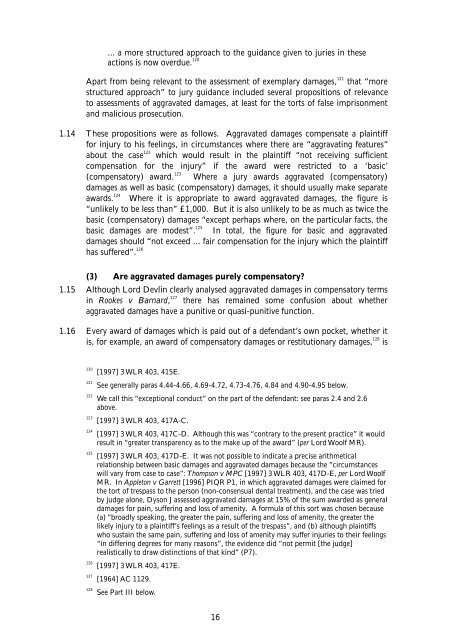Aggravated, Exemplary and Restitutionary ... - Law Commission
Aggravated, Exemplary and Restitutionary ... - Law Commission
Aggravated, Exemplary and Restitutionary ... - Law Commission
Create successful ePaper yourself
Turn your PDF publications into a flip-book with our unique Google optimized e-Paper software.
... a more structured approach to the guidance given to juries in these<br />
actions is now overdue. 120<br />
Apart from being relevant to the assessment of exemplary damages, 121<br />
that “more<br />
structured approach” to jury guidance included several propositions of relevance<br />
to assessments of aggravated damages, at least for the torts of false imprisonment<br />
<strong>and</strong> malicious prosecution.<br />
1.14 These propositions were as follows. <strong>Aggravated</strong> damages compensate a plaintiff<br />
for injury to his feelings, in circumstances where there are “aggravating features”<br />
about the case 122<br />
which would result in the plaintiff “not receiving sufficient<br />
compensation for the injury” if the award were restricted to a ‘basic’<br />
(compensatory) award. 123<br />
Where a jury awards aggravated (compensatory)<br />
damages as well as basic (compensatory) damages, it should usually make separate<br />
awards. 124<br />
Where it is appropriate to award aggravated damages, the figure is<br />
“unlikely to be less than” £1,000. But it is also unlikely to be as much as twice the<br />
basic (compensatory) damages “except perhaps where, on the particular facts, the<br />
basic damages are modest”. 125<br />
In total, the figure for basic <strong>and</strong> aggravated<br />
damages should “not exceed ... fair compensation for the injury which the plaintiff<br />
has suffered”. 126<br />
(3) Are aggravated damages purely compensatory?<br />
1.15 Although Lord Devlin clearly analysed aggravated damages in compensatory terms<br />
in Rookes v Barnard, 127<br />
there has remained some confusion about whether<br />
aggravated damages have a punitive or quasi-punitive function.<br />
1.16 Every award of damages which is paid out of a defendant’s own pocket, whether it<br />
is, for example, an award of compensatory damages or restitutionary damages, 128<br />
is<br />
120 [1997] 3 WLR 403, 415E.<br />
121 See generally paras 4.44-4.66, 4.69-4.72, 4.73-4.76, 4.84 <strong>and</strong> 4.90-4.95 below.<br />
122 We call this “exceptional conduct” on the part of the defendant: see paras 2.4 <strong>and</strong> 2.6<br />
above.<br />
123 [1997] 3 WLR 403, 417A-C.<br />
124 [1997] 3 WLR 403, 417C-D. Although this was “contrary to the present practice” it would<br />
result in “greater transparency as to the make up of the award” (per Lord Woolf MR).<br />
125 [1997] 3 WLR 403, 417D-E. It was not possible to indicate a precise arithmetical<br />
relationship between basic damages <strong>and</strong> aggravated damages because the “circumstances<br />
will vary from case to case”: Thompson v MPC [1997] 3 WLR 403, 417D-E, per Lord Woolf<br />
MR. In Appleton v Garrett [1996] PIQR P1, in which aggravated damages were claimed for<br />
the tort of trespass to the person (non-consensual dental treatment), <strong>and</strong> the case was tried<br />
by judge alone, Dyson J assessed aggravated damages at 15% of the sum awarded as general<br />
damages for pain, suffering <strong>and</strong> loss of amenity. A formula of this sort was chosen because<br />
(a) “broadly speaking, the greater the pain, suffering <strong>and</strong> loss of amenity, the greater the<br />
likely injury to a plaintiff’s feelings as a result of the trespass”, <strong>and</strong> (b) although plaintiffs<br />
who sustain the same pain, suffering <strong>and</strong> loss of amenity may suffer injuries to their feelings<br />
“in differing degrees for many reasons”, the evidence did “not permit [the judge]<br />
realistically to draw distinctions of that kind” (P7).<br />
126 [1997] 3 WLR 403, 417E.<br />
127 [1964] AC 1129.<br />
128 See Part III below.<br />
16
















